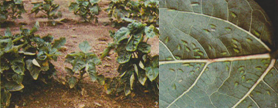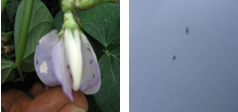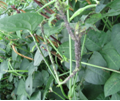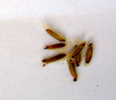Insects - cowpea
Contributors to this section: IITA, Nigeria (M. Ayodele, L. Kumar).
Scientific name
Aphis craccivora
Other scientific names
Aphis medicaginis auct. nec. Koch, 1854
Aphis leguminosae Theobald, 1915
Pergandeida craccivora Koch
Importance
High
Significance
This Aphid is a major economic pest of cowpea. The aphid while feeding removes sap from the leaves, pods, seeds and other aerial plant parts causing damage to the plant resulting in yield reductions.
From experimental data and results, infestation with A. craccivora caused significant reductions in seed yield. (Ofuya, 1989). In a Chinese study A. craccivora infestation, resulted in a reduction in plant height to 41.9% , green leaf area and delayed production of harvestable pods by 30 days (Chang and Thrower, 1981).
Infestations of A. craccivora on cowpeas caused reduction in growth and losses in yield (Annan et al., 1995). Attia et al., (1986). Bishara et al., (1984), reported that A. craccivora was the most damaging pest of cowpeas in Egypt, particularly early in the growing season.
In addition to loss due to damage caused by the aphid, A. craccivora is known to be an important vector of plant viral disease, transmitting over 30 plant viruses, (Wightman and Wightman, 1994).
The aphid also produces honeydew, a substrate which attracts fungi (Mayeux, 1984).
Symptoms
The aphids attacks all growing stages and parts of the plant : flowering, seedling and vegetative growing , points including the leaves and the plant as a whole.
Leaves: distortion, stunting of leaflets, lesions; abnormal colours; premature defoliation; sooty mould
Pod : shrivelling. (Ofuya, 1995; Bottenberg et al., 1998).
Growing points: rosette
Seed : shrivelling
Whole plant : stunting, deformities and yield reductions. (Annan et al., 1997)
|
Infested cowpea plant (photo:IITA) |
Aphids |
Hosts
The insect feeds on several plants causing damage. Some reported hosts are Vigna unguiculata (cowpea), Arachis hypogaea (groundnut), Cajanus cajan (pigeon pea), Medicago sativa (lucerne), Vigna radiata (mung bean), Capsicum (peppers), Chenopodium quinoa (quinoa), Cicer arietinum (chickpea), Citrus , Gossypium (cotton), Lablab purpureus (hyacinth bean), Lupinus (lupins), Lycopersicon esculentum (tomato), Phaseolus (beans), Phaseolus vulgaris (common bean), Sesamum indicum (sesame), Solanum tuberosum (potato), Theobroma cacao (cocoa), Trifolium (clovers), Vicia faba (broad bean), Vigna catjang , Vigna mungo (black gram).
Geographic distribution
World wide in distribution. It has been reported in Europe, Asia, Africa, Central America, Canada, Mexico, USA, Argentina, Bolivia, Brazil, Chile, Venezuela, Australia, Fiji, New Zealand.
Biology and transmission
Is a shiny black aphid, feeding on the undersurface of the cowpea leaves ,young stems an pods.
Parthenogenetic reproduction occurrs all year round. The aphid is ovoviviparous, The females retain eggs inside their bodies and give birth to small larvae.Young colonies of this small aphids are found on growing points of plants in association with ants. (Soans and Soans, 1971; Patro and Behera, 1991).
Although A. craccivora is polyphagous, it has preference for Leguminosae.
A. craccivora is dispersed by wind. ( dispersal of the winged forms).
Detection/indexing methods used at IITA
Field inspection during active growth and in storage
Dry seed inspection:
- Spread the seed sample on the seed picking tray.
- Inspect visually using hand lens to pick out insects, seeds that are discolored, damaged or infested, shrunken, malformed, etc. and record on the scoring sheet.
- Place the cover on the seed picking tray and turn over to inspect the other side of the seeds.
- Based on both observations, give a score of 0-5 for each category: 0=no incidence; 1=1-20% incidence; 2=21-40% incidence; 3=41-60% incidence; 4=61- 80% incidence; and 5=81-100% incidence.
- Identification using the Stereo microscope/ visual
Treatment
Chemical pesticides used for the control of the aphid and ants on the field during active growth:
Chemical control
- Act force 100ml to 20lts water or
- Cyper force 100ml to 20lts water or
- Cyper Diforce 100ml to 20lts water
Protocol
- Spray cowpea with any of the above mentionned insecticide at 7-10 days interval beginning from flower bud initiation.
- In case of severe aphids /ant infestation during seedling stage, one spray may be needed before flowering. Normally four applications of insecticide are adequate to control the insect pests.
- Seed treatment using any available pesticide / seed fumigation using phostoxin
Cultural
- Use insect resistant varieties
- Multiplication plots and environs should be weed and ants free
Procedures in case of positive test at IITA
- Infested lines are incinerated. Not acceptable for international distribution
References and further reading
Annan IB, Schaefers GA, Tingey WM. 1995. Influence of duration of infestation by cowpea aphid (Aphididae) on growth and yield of resistant and susceptible cowpeas. Crop Protection, 14(7):533-538.
Annan IB, Ampong-Nyarko K, Tingey WM, Schaefers GA. 1997. Interactions of fertilizer, cultivar selection, and infestation by cowpea aphid (Aphididae) on growth and yield of cowpeas. International Journal of Pest Management, 43(4):307-312.
Attia AA, El-Heneidy AH, El-Kady EA. 1986. Studies on the aphid, Aphis craccivora, Koch. (Homoptera: Aphididae) in Egypt. Bulletin de la Société Entomologique d'égypte, No. 66:319-324.
Bishara SI, Fam EZ, Attia AA, El-Hariry MA. 1984. Yield losses of faba bean due to aphid attack. FABIS Newsletter, Faba Bean Information Service, ICARDA, No. 10:16-18.
Bottenberg H, Tamò M, Singh BB. 1998. Occurrence of phytophagous insects on wild Vigna sp. and cultivated cowpea: comparing the relative importance of host-plant resistance and millet intercropping. Agriculture, Ecosystems & Environment, 70(2/3):217-229
Mayeux A. 1984. The groundnut aphid. Biology and control. Oléagineux, 39(8/9):425-434; [
Ofuya TI. 1989. The effect of pod growth stages in cowpea on aphid reproduction and damage by the cowpea aphid, Aphis craccivora (Homoptera: Aphididae). Annals of Applied Biology, 115(3):563-566.
Patro B, Behera MK. 1991. Mutualism between the bean aphids (Aphis craccivora Koch) and ants. Orissa Journal of Agricultural Research, 4(3-4):238.
Soans AB, Soans JS. 1971. Proximity of the colonies of the tending ant species as a factor determining the occurrence of aphids. Journal of the Bombay Natural History Society, 68(3):850-851
Wightman JA, Wightman AS. 1994. An insect, agronomic and sociological survey of groundnut fields in southern Africa. Agriculture, Ecosystems & Environment, 51(3):311-331.
Bean pod borer, Legume pod borer, Cowpea pod borer
Scientific name
Maruca vitrata
Other scientific names
Maruca testulalis Geyer
Crochiphora testulalis Geyer
Importance
High
Significance
Loss in yield not quantified but it is a major cowpea pest in Nigeria .(Odulaja and Oghiakhe 1993).
Symptoms
Maruca feeds on the tender stems, flower buds, flowers, peduncles, pods, and leaves causing damage to all the plant parts. Symptoms found on:
Flowers: round holes,
Leaves: holes
Pods: distortion
Hosts
The insect attacks 39 hosts of which 37 are leguminous as reported by Rathore and Lal (1998). Arodokoun (1996) listed 23 host plants of M. vitrata in Benin Republic. Some recorded hosts of concern to peasant farmers in the tropics include Vigna unguiculata (cowpea), Cajanus, Cajanus cajan (pigeon pea), Canavalia, Canavalia ensiformis (gotani bean), Fabaceae (leguminous plants), Glycine, Lablab purpureus (hyacinth bean), Phaseolus (beans), Phaseolus lunatus (lima bean), Phaseolus vulgaris (common bean) and Pueraria phaseoloides (tropical kudzu).
Geographic distribution
Belgium, Denmark, France, UK, Asia, China, India, Indoneia, Iran, Japa, Korea, Malaysia, Nepal, Sri Lanka, Thailand, Singapore, Vietnam, Africa, Central America, Mexico, USA, S. America, Australia, Fiji, Papua New Guinea.
Biology and transmission
Adults are not active during the day. They are usually found at rest under the lower leaves of the host plant. They live for an average of 6-10 days, each female laying up to 200 eggs. Ke et al. (1985) recorded seven generations per year in China.
Detection/indexing methods used at IITA
Field inspection during active growth and inspection during storage
Dry seed inspection
- Spread the seed sample on the seed picking tray.
- Inspect visually using hand lens to pick out insects, seeds that are discolored, damaged or infested, shrunken, malformed, etc. and record on the scoring sheet.
- Place the cover on the seed picking tray and turn over to inspect the other side of the seeds.
- Based on both observations, give a score of 0-5 for each category: 0=no incidence; 1=1-20% incidence; 2=21-40% incidence; 3=41-60% incidence; 4=61- 80% incidence; and 5=81-100% incidence.
- Identification under the stereomicroscope/ visual
Treatment
- Plant resistant varieties. (IITA has an insect Rearing Unit which rears Maruca sp for research work on Host pest resistance
- Crop rotation
- Biological control, Insect sterility, Use of pheromones/trapping
- Good Agricultural Practice ( Weed free plots)
Chemical control
- Chemical pesticides used for the control of Maruca on the field during active growth:
- Act force 100ml to 20lts water or
- Cyper force 100ml to 20lts water or
- Cyper Diforce 100ml to 20lts water
Procedures in case of positive test at IITA (Discard)
- Infested lines are incinerated. Not acceptable for international distribution
References and further reading
Arodokoun DY. 1996. Importance des plantes-hotes alternatives et des ennemis naturels indigenes dans le controle biologique de Maruca testutalis Geyer (Lepidoptera, Pyralidae), ravageur de Vigna unguiculata Walp. PhD thesis. Quebec, Canada: Universite Laval, 182.
Ke LD, Fang JL, Li ZJ. 1985. Bionomics and control of the legume pod-borer Maruca testulalis Geyer. Acta Entomologica Sinica, 28(1):51-59.
Odulaja A, Oghiakhe S. 1993. A nonlinear model describing yield loss in cowpea (Vigna unguiculata) due to the legume pod borer, Maruca testulalis Geyer (Lepidoptera: Pyralidae). International Journal of Pest Management, 39(1):61-63.
Rathore YS, Lal SS. 1998. Phylogenetic relationship of host plants of Maruca vitrata.
Indian Journal of Pulses Research, 11(2):152-155.
Singh, S R. 1977. Grain legume Entomology, IITA, Ibadan, Nigeria., 55 pp.
|
Adult on cowpea (photo:IITA) |
Larva stage (photo:IITA) |
Pupa stage (photo:IITA) |
Cowpea weevil, Spotted cowpea bruchid, Cowpea seed beetle
Scientific name
Callosobruchus spp.
Other scientific names
Bruchus quadrimaculatus Fabricius 1792
Callosobruchus ornatus (Boheman 1829)
Importance
High
Significance
In Nigeria, yield loss was estimated to 3% of the annual production in 1961/62 . Infestation starts in the pods in the field and are carried over into storage where infestation continues and substantial losses occur (Ojimelukwe et al., 1999). Decrease seed /grain quality.
Symptoms
The insect attacks the fruiting stage, seeds and all stored grains and products.
Pod : eggs cemented to the surface.
Seeds : Round holes.
Hosts
C. maculatus is a major pest of cowpeas, green gram and lentils).
The hosts attacked are Vigna unguiculata (cowpea), Acacia nilotica (gum arabic tree), Cajanus cajan (pigeon pea), Glycine max (soyabean), Phaseolus (beans), stored products (dried stored products), Vigna radiata (mung bean), and Voandzeia subterranea (bambara groundnut).
Geographic distribution
C. maculatus is widely distributed throughout the tropics and sub-tropics. It is found in China, India, Iran, Pakistan, Sri Lanka, Turkey, Africa, Nicaragua, USA, Brazil, Peru, Venezuela, Australia.
Biology and transmission
Adult Callosobruchus maculatus do not feed on stored products. Short lived having a life span of no more than 12 days. Females lay many eggs up to 115 eggs.The beettle lays eggs on maturing cowpea pods.
Detection/indexing methods used at IITA
Field inspection during active growth and inspection of stored seeds for conservation
Dry seed inspection:
- Spread the seed sample on the seed picking tray.
- Inspect visually using hand lens to pick out insects, seeds that are discolored, damaged or infested, shrunken, malformed, etc. and record on the scoring sheet.
- Place the cover on the seed picking tray and turn over to inspect the other side of the seeds.
- Based on both observations, give a score of 0-5 for each category: 0=no incidence; 1=1-20% incidence; 2=21-40% incidence; 3=41-60% incidence; 4=61- 80% incidence; and 5=81-100% incidence.
- Visual and stereomicroscopic Identification
Treatment/cControl
- Chemical pesticides used for the control in the field and under storage.
- Fumigation of the storage facility
- Seed treatment with phostoxin
Cultural
- Host-Plant Resistance. Resistant varieties are available in IITA
- Harvesting at the right time to prevent infestation of pods in the field
- Cold storage at 4oC
Procedures in case of positive test at IITA
- Discard. Infested lines are incinerated. Not acceptable for international distribution
References and further reading
Ojimelukwe PC, Onweluzo JC, Okechukwu E. 1999. Effects of infestation on the nutrient content and physicochemical properties of two cowpea (Vigna unguiculata) varieties. Plant Foods for Human Nutrition, 53(4):321-332.
 |
 |
 |
 |
|
Cowpea weevil, Source Ayodele/Oguntade (IITA) |
|||
Scientific name
Empoasca spp.
Other scientific name
Empoasca dolichi
Importance
High
Significance
Not reported.
Symptoms
Emposca attacks cowpea seedlings causing
Leaves :discoloration of veins and margins, cupping
Whole plant : stunting, pre mature drying of the plant.
 Empoasca dolichi (photos: IITA) |
Hosts
The leaf hoppers attack Vigna unguiculata (cowpea), Arachis hypogaea (groundnut), and Gossypium (cotton).
Geographic distribution
Africa, Nigeria
Biology and transmission
The hopper lays eggs on the underside of the leaves. Adults expentancy life varies from 30-60 days.
Detection/indexing methods used at IITA
Field inspection during active growth
Dry seed inspection
- Spread the seed sample on the seed picking tray.
- Inspect visually using hand lens to pick out insects, seeds that are discolored, damaged or infested, shrunken, malformed, etc. and record on the scoring sheet.
- Place the cover on the seed picking tray and turn over to inspect the other side of the seeds.
- Based on both observations, give a score of 0-5 for each category: 0=no incidence; 1=1-20% incidence; 2=21-40% incidence; 3=41-60% incidence; 4=61- 80% incidence; and 5=81-100% incidence.
- Visual inspection
Treatment/control
Cultural
- Use resistant varieties
- Planting site sanitation
- Field inspection during active growth
- Removal of infested residues after harvest
- Selection of pest free seeds after threshing for storage
- Seed cold storage at 4oC
- Good store hygiene
Chemical control, applying sprays during active growth with either:
- act force 100ml to 20lts water or
- cyper force 100ml to 20lts water or
- cyper Diforce 100ml to 20lts water.
Protocol
- Spray cowpea with any of the above mentionned insecticide at 7-10 days interval beginning from flower bud initiation.
- In case of severe infestation during seedling stage, one spray may be needed before flowering. Normally four applications of insecticide are adequate to control the insect pests.
Procedures in case of positive test at IITA
- Discard. Infested lines are incinerated. Not acceptable for international distribution
References and further reading
Singh SR. 1977. Grain Legume Entomology,IITA, Ibadan, Nigeria,., 55pp
Singh SR. 1977. Tropical Grain Legume Bull.9.1-7
Singh RS, van Emden HF. 1998. Ann.Rev. Entom., 24, Rev, 255-278
Scientific name
Ophiomyia phaseoli
Other scientific names
Melanagromyza phaseoli Vanschuytebroeck, 1951
Agromyza phaseoli Coquillett, 1899
Agromyza destructor Malloch, 1916
Importance
High
Significance
The bean fly is a serious and destructive pest of cow pea and other edible legumes in the tropical and subtropical regions of Asia Talekar (1990.
In Tanzania yield loss which ranges from 30-50% were reported by Wallace, (1939; Walker, (1960). Also, in 1985, the Asian Vegetable Research and Development Center (AVRDC), reported that in Taiwan damage caused by the fly reduced cowpea yield by 32%.
Symptoms
Symptoms caused by the fly are exhibited on various plant parts where they feed and lay eggs,
Leaves : punctures on the upper side, light yellow spots, larval mines turn dark brown, blotchy and drooping, defoliation
Trifoliate leaves : egg holes, silvery, curved stripes of larval mines which are visible on the underside of the leaves , visible tunnels on the upper side of the leaves.
Leaf petiole : swollen
Root : tunnelling , cortex destruction, swollen
Stem : Tunnelling
Whole plant : stunting , Wilting
Hosts
Vigna unguiculata (cowpea) has been reported as a minor host of this fly. Listed major hosts are Fabaceae (leguminous plants), Phaseolus (beans), Phaseolus vulgaris; (common bean), Vigna radiata (mung bean). Minor and wild hosts of the fly have also been reported which include: Cajanus cajan (pigeon pea), Glycine max (soyabean), Phaseolus lunatus (lima bean), Pisum sativum (pea), Psophocarpus tetragonolobus (winged bean), Vigna angularis (adzuki bean), and Vigna mungo (black gram).
Geographic distribution
Bangladesh, China, India, Indonesia, , Iran, Israel, Japan, Jordan, Malaysia, Nepal, Pakistan, Singapore, Saudi Arabia, Sri Lanka, Thailand, Vietnam, Africa, USA, Australia, Fiji, Papua New Guinea
Biology and transmission
The famales of the bean fly are very active on warm clear days seeking young tender leaves for oviposition. Eggs are laid during the morning hours on the upper side of the leaves, often near the midrib close to the petiole.
Burikam (1980) reported that females lay an average of 77 eggs in cowpea. The adult females live for 23-42 days and males for 31-38 days, and if no food is provided they die in 2-3 days ( Raros (1975) .
Detection/indexing methods used
Field inspection during active growth
Dry seed inspection
- Spread the seed sample on the seed picking tray.
- Inspect visually using hand lens to pick out insects, seeds that are discolored, damaged or infested, shrunken, malformed, etc. and record on the scoring sheet.
- Place the cover on the seed picking tray and turn over to inspect the other side of the seeds.
- Based on both observations, give a score of 0-5 for each category: 0=no incidence; 1=1-20% incidence; 2=21-40% incidence; 3=41-60% incidence; 4=61- 80% incidence; and 5=81-100% incidence.
- Visual and stereomicroscopic identification
Treatment/control
Cultural
- Use resistant varieties
- Planting site sanitation
- Field inspection during active growth
- Removal infested residues after harvest
- Selection of pest free seeds after threshing for storage
- Seed cold storage at 4oC
Chemical control
- Seed treatment using carbofuran
- Applying sprays during active growth with either
- Act force 100ml to 20lts water or
- Cyper force 100ml to 20lts water or
- Cyper Diforce 100ml to 20lts water
Protocol
- Spray cowpea with any of the above mentionned insecticide at 7-10 days interval beginning from flower bud initiation.
- In case of severe flies infestation during seedling stage, one spray may be needed before flowering. Normally four applications of insecticide are adequate to control the insect pests.
Procedures in case of positive test at IITA
- Discard. Infested lines are incinerated. Not acceptable for international distribution
References and further reading
AVRDC. 1985. 1983 Progress report. Shanhua, Taiwan: Asian Vegetable Research and Development Center
Burikam I. 1978. Ecological investigation of the bean fly, Ophiomyia phaseoli (Tryon) (Diptera: Agromyzidae) and its natural enemies in Thailand., 71 pp.; [24 fig., unpublished M.Sc. thesis]
Raros ES. 1975. Bionomics of bean fly, Ophiomyia phaseoli (Tryon) (Diptera: Agromyzidae) and its parasites in Hawaii. Ph. D. Thesis. Honolulu, USA: Department of Entomology, University of Hawaii.
Talekar NS. 1990. Agromyzid flies of food legumes in the tropics. New Delhi, India: Wiley Eastern Limited
Walker PT. 1960. Insecticide studies in East African agricultural pests. III. Seed dressing for the control of beanfly, Melanagromyza phaseoli (Coq.) in Tanganyika. Bulletin of Entomological Research, 50:781-793.
Wallace GB. 1939. French bean diseases and bean fly in East Africa. East African Agricultural Journal, 5:170-175.
Flower Thrips, Bean flower thrips, African bean thrips
Scientific name
Megalurothrips sjostedti Trybom, 1908.
Other scientific names
Taeniothrips sjostedti Trybom
Lundathrips inopinatus Bournier, 1979.
Importance
High
Significance
These Thrips are responsible for the total cowpea yield loss in West Africa
Serious infestation causing the loss of flower resulting to complete loss of yield was reported by Childers and Achor, (1995). Alghali (1992) reported that in Nigeria, yield loss of cowpeas was up to 75% when insects attacked during the flower budding and flowering stages.
Symptoms
The Thrips attack the flowering stage infesting the inflorescence and leaves.
Childers and Achor, ( 1995) reported that feeding by M. sjostedti which begins before the flowers open, damages various parts of the cowpea plant especially the flowers. Infestation of the flower and other plant parts results to:
Inflorescence: distortion and discolouration, abortion, reduced pollen production and flower loss
Leaves: Defoliation
Whole plant : death, yield reduction
 Megalurothrips sjostedti(photos:IITA) |
Hosts
Legumes are the main hosts of M. Sjostedti and this include Vigna unguiculata (cowpea), Cajanus cajan (pigeon pea), Phaseolus vulgaris (common bean). Tamo et al. (1993b).They also attack some other plants considered as minor hosts such as Arachis hypogaea (groundnut), and some wild hosts.
Geographic distribution
Reported to be found throughout Sub-Saharan Africa, from the high rainfall areas of West to the semi-arid areas of Kenya and Sudan. Meanwhile in Nigeria, it is associated with the dry savanna regions in which cowpeas are produced.
Biology and transmission
Rapid breeding, laying eggs on leaf petioles, peduncles , inflorescences and pods was reported by Tamo et al., (1993a). Salifu, (1992) reported that development from egg to adult takes about 19 days at 29°C and 58% RH and adults live for about 23 days.
Taylor (1969) reported that the infestation of cowpea plants begin just before flowering. That the adults fligh by day, with the peak of flight activity occurring between noon and 1 pm at a temperature 23-24°C. It had been observed that, both temperature and light intensity influence flight.
Detection/indexing methods used at IITA
Field inspection during active growth.
Dry seed inspection:
- Spread the seed sample on the seed picking tray.
- Inspect visually using hand lens to pick out insects, seeds that are discolored, damaged or infested, shrunken, malformed, etc. and record on the scoring sheet.
- Place the cover on the seed picking tray and turn over to inspect the other side of the seeds.
- Based on both observations, give a score of 0-5 for each category: 0=no incidence; 1=1-20% incidence; 2=21-40% incidence; 3=41-60% incidence; 4=61- 80% incidence; and 5=81-100% incidence.
- Visual and stereomicroscopic identification
Treatment
Cultural
- Use resistant varieties
- Planting site sanitation
- Field inspection during active growth
- Removal of infested residues after harvest
- Selection of pest free seeds after threshing for storage
Chemical control, applying sprays during active growth with any of the pesticides
- Act force 100ml to 20lts water or
- Cyper force 100ml to 20lts water or
- Cyper Diforce 100ml to 20lts water
Protocol
- Spray cowpea with any of the above mentionned insecticide at 7-10 days interval beginning from flower bud initiation.
- In case of severe Thrips infestation during seedling stage, one spray may be needed before flowering. Normally four applications of insecticide are adequate to control the insect pests.
Biological control
- Research on going on the use of parasitoids and entomopathogens.
Procedures in case of positive test at IITA
- Infested lines are incinerated. Not acceptable for international distribution
References and further reading
Alghali AM. 1992. Insecticide application schedules to reduce grain yield losses caused by insects of cowpea in Nigeria. Insect Science and its Application, 13(5):725-730
Childers CC, Achor DS. 1995. Thrips feeding and oviposition injuries to economic plants, subsequent damage and host responses to infestation. In: Parker BL, et al., eds. Thrips Biology and Management. New York, USA: Plenum Press.
Salifu AB. 1992. Some aspects of the biology of the bean flower thrips Megalurothrips sjostedti (Trybom) (Thysanoptera: Thripidae) with reference to economic injury levels on cowpea (Vigna unguiculata (L.) Walp). Revue de Zoologie Africaine, 106(5):451-459.
Tamò M, Baumgärtner J, Arodokoun DY. 1993. The spatio-temporal distribution of Megalurothrips sjostedti (Trybom) (Thysanoptera, Thripidae) life stages on cowpea, and development of sampling plans. Mitteilungen der Schweizerischen Entomologischen Gesellschaft, 66(1-2):15-34.
Tamò M, Baumgärtner J, Delucchi V, Herren HR. 1993. Assessment of key factors responsible for the pest status of the bean flower thrips Megalurothrips sjostedti (Thysanoptera: Thripidae) in West Africa. Bulletin of Entomological Research, 83(2):251-258
Taylor TA. 1969. On the population dynamics and flight activity of Taeniothrips sjostedti (Tryb.) (Thysanoptera:Thripidae) on cowpea. Bulletin of the Entomological Society of Nigeria, 1969:60-71.
Comments
- No comments found










Leave your comments
Post comment as a guest